Planetary systems and their changing theories
 table of
contents of "Planetary systems and their changing theories"
table of
contents of "Planetary systems and their changing theories"
 next topic
next topic
4. Other worlds predicted and
interpreted by theory: Limit of growth in a disk: does it exist?
The theory up to 1996
predicted ~1 Jupiter mass as a gap-opening mass
(in a standard solar nebula), and
identified it with the mass limit.
Gap formation was synonymous with the termination of planet growth.
The concept of an impermeable gap around the secondary component
was also standard in disk-binary star interaction theory.
Much has changed since then in the disk-binary theory and
observations:
- Artymowicz & Lubow (1996) proposed that mass flows through
circumbinary gaps (CB gaps) in PMS binaries.
They also proposed that there is no
principal limit on how large a dm/dt the gap can transmit.
- GG Tau, a classical T Tau (PMS) double star
whose CB disk has been imaged by Roddier et al (1996)
in J-K bands with
adaptive optics, shows possible signature of gas inside an
almost empty CB gap.
- Mathieu, Stassun, Basri et al. (1997) analyzed
DQ Tau, a double-lined spectroscopic binary,
showing photometric variability consistent with the dynamical model
(periastron brightening). DQ Tau does not have much space for
circumstellar disks, yet shows all the signs of active accretion.
- Basri, Johns-Krull & Mathieu (1997) found
spectroscopic features in DQ Tau
supporting the model with a flow from a CB disk.
- Jensen & Mathieu (1997) showed that several of the PMS binaries
interacting with CB disks can have mass streaming through the CB gap.
- Bouvier et al. (1997) observed 144 G & K dwarfs in Pleiades.
They did not see any significant difference between the distributions
of rotational velocities of single and binary stars.
This implies that accretion onto both types of stars is similar,
and in case of binaries must proceed from a CB disk.
- Koresco et al (1997) identified a class of "embedded IR companions" to
PMS stars as secondaries in binary systems, accreting through gap
from the CB disks according to dynamical model.
- Close et al. (1998) discovered that UY Aur is surrounded by
a CB disk, similar to GG Tau, which has been imaged with adaptive optics.
This system shows evidence of streamers of gas falling onto the
binary from a CB disk.
Regarding the planets, Artymowicz & Lubow (1996)
suggested that under favorable conditions mass may flow through
circumplanetary gap in protoplanetary disks, to convert Jupiters into
superplanets in some exoplanetary systems.
They pointed out (Artymowicz & Lubow 1997)
that large planets are no less effective in accreting through the gap
than huge secondaries
(i.e. stars) because the gap is much wider and presumably not easier to
cross in binary stars, compared with the planetary systems.
We have confirmed this hypothesis with a wide range of
numerical methods (Artymowicz, Lubow, and Kley 1998).
We use the following top-rated,
variable resolution
hydrodynamical methods to study the flows and disk-planet interaction:
- SPH = Smoothed particle hydrodynamics, a Lagrangean (particle) method.
- Monotonic Transport code of Kley,
- PPM = Piece-wise Parabolic Method in a Lagrangean+Eulerian formulation
- Zeus code
Our models are carefully tested
adaptations and developments of the above methods
for the specific disk-planet problem.
Some results of SPH
(from Artymowicz & Lubow 1997, Tenerife conf. proc.,
in print):
a 5 Jupiter mass planet, accreting through a disk gap via extensions
of stream-like features. The empty circle on the right is
approximately the size of the Roche lobe of the planet.
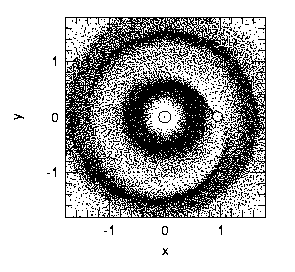
Some early results of a Monotonic Transport Hydrocode.
The horizontal axis in this
plot covers the whole range of azimuthal
angle phi from 0 to 360 degrees.
The vertical axis is radius, in terms of planetary radius.
(The planets has 1 Jupiter mass and a circular orbit.)
Suface density is color-coded.
The gap was created by a planet (horizontal dark band) but there is
some gas crossing the gap, in a form of spiral shock waves reaching down
to the Lagrange points of the planet
(the vertically elongated object in the gap is the Roche lobe
being filled by gas).
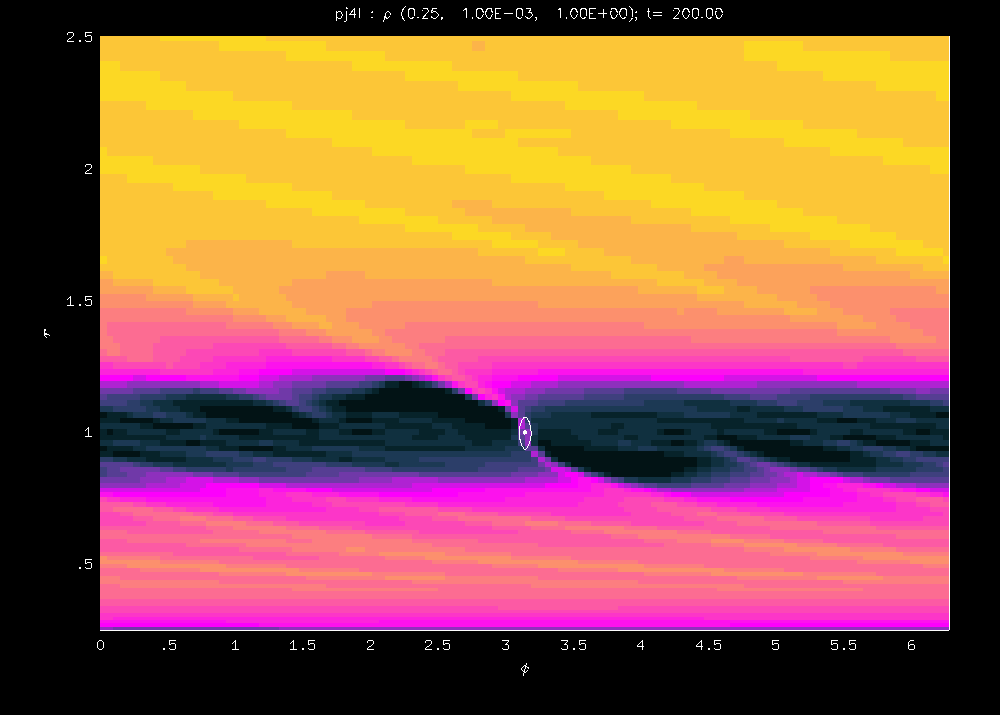
The figure below, obtained at higher resolution by the same method,
was published in a recent Science magazine editorial
by J. Glanz (Science, 30 May 97, special issue on stellar astronomy).
The caption said "Feeding frenzy. Even after a newborn giant planet
tears a gap in a protoplanetary disk, material might stream
in and feed continued growth."
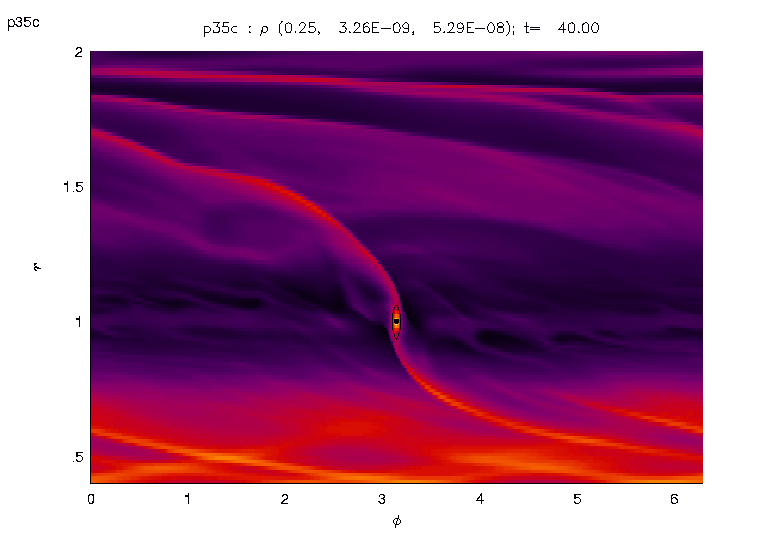
And by clicking
here
you can see a detailed version of a
zoom on the planet region with superimposed
flow field, simulated with monotonic transport code:

Some results of a Piecewise Parabolic Method hydrocode.
An accreting Jupiter (Roche lobe emptied during simulation)
in r-phi coordinate surface density plot:
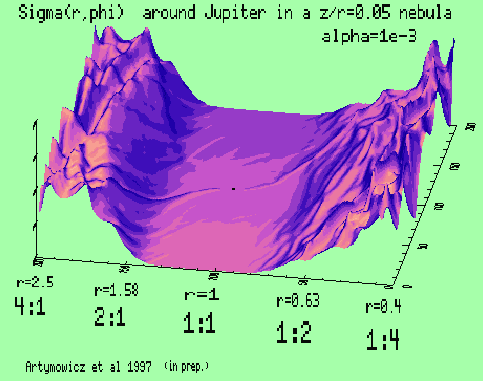
In this simulation, Jupiter would double in mass in time equal to
5*104 P (orbital periods), i.e. 0.6 Myr, if the surrounding disk
has mass 0.01 Msun, despite a very wide gap extending to
1:2 and 2:1 orbital commensurabilities. (Realistic gap sizes
are expected to be somewhat smaller for Jupiter). This simulation
could thus produce a superplanet during the lifetime of a solar nebula.
Finally, we provide two pictures zooming in
on the region around the Roche lobe of the
(non-accreting) proto-Jupiter. (The Roche lobe radius equals 0.069 times
the orbital radius of a Jupiter.)
The first JPEG picture below is a top view of
gas density distribution around the Jupiter-sized protoplanet (center)
that opened a gap in the solar nebula-type disk.
It will be published, among others,
in the proceedings of XIX Rencontres de Blois, "Planetary
systems: the long view" (Artymowicz, Lubow, and Kley 1997).
Disk properties are as above (e.g., viscosity parameter alpha=10-3
is used in Navier-Stokes viscous terms; z/r=0.05). The numerical
grid near the planet has resolution approximately 0.009 times
the star-planet distance. Thus, we begin to resolve the structure
in gas flowing into the
white oval, representing the sphere of
influence or Roche lobe of the planet. Spiral shocks bridge the
disk gap and supply the growing planet with gas
through the cusps on the Roche lobe (Lagrange points).
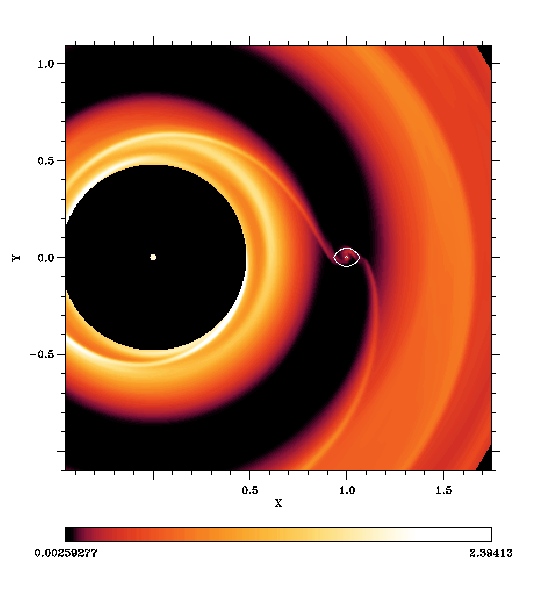
Most of the disk gas returns to disk after passing the shock, but
a small fraction hitting the shock near the L points falls inside
the Roche lobe. Additional rarefied gas streams directly from
the horeseshoe orbits in the gap.
The above picture appeared in a popular article on extrasolar planets
by Geoff Marcy and Paul Butler
(HTML).
Below we show the enlargement of gas density around
the much better resolved Roche
lobe of Jupiter from another simulation (PPM, P.A. 1999).
Several features are evident:
The wakes are seen on both sides of the Roche lobe, resembling
in nature the keel-water of a boat or a shock wave behind a supersonic
plane (of course most of the disk does rotate supersonically with respect to
the planet).
The wake joins the bow shock in front of the Roche lobe, intercepting
the gas streaming along the horseshoe orbits. But this set of shocks
is much less apparent than the third set of shocks, which are
found inside the circumplanetary disk inside the lobe.
The very pronounced m=2 wave results from the
external flow configuration. The flow is analysed in
detail in a paper in Astroph. J. (Dec. 1999) by Lubow, Seibert and
Artymowicz. The
central gas clump is a poorly resolved, small
circumjovian disk.
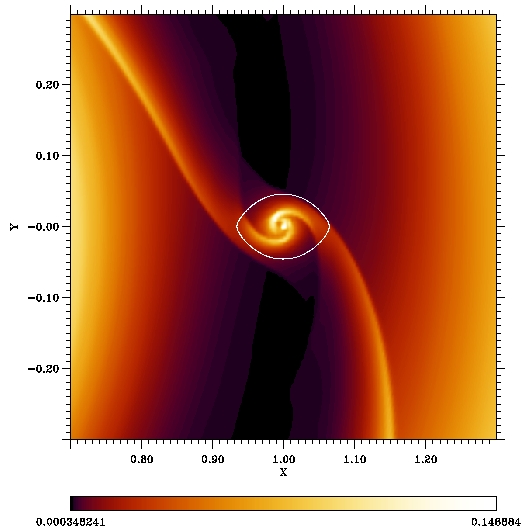
Similar circumplanetary flows were also obtained in Zeus hydrocode
and SPH-based runs.
All our results support the hypothesis that, contrary to
the common assumption,
the tidal gap opening
does not provide a principal limitation on planet growth in a disk.
In other words, there is always
some gas flow from inner and outer disk onto the planet; the only question is
whether in a particular disk it is efficient enough to trasform
a giant in to a 'supergiant' planet. Our simulations show that it is,
for many plausible disk models.
Therefore, reasons involving disk lifetime (the timing of disk
dispersal) and the availability of sufficient
amount of gas might determine the final (super)planet masses.
(Incidentally, this is not a new idea.
Similar conclusions as to the masses of 3 out of 4
giant planets in the solar system (all except Jupiter)
have been reached already in the standard theories from the 1980s.)
All this, together with the eccentricity excitation mechanism discussed
earlier, provides a plausible and self-contained scenario for the origin of
superplanets in some extrasolar systems, not necessarily typical,
perhaps those which
possessed long-lived, or massive, or unusually viscous, or hot disks.
The formation of brown dwarfs in some disks is entirely possible,
though may be rare, mainly because of insufficient disk mass.
Preliminary results of PPM calculation of planets of various
masses in different disks are shown in
http://www.astro.su.se/~pawel/planets/results.html
.
 table of
contents
table of
contents
 next topic
(Conclusions page)
next topic
(Conclusions page)






